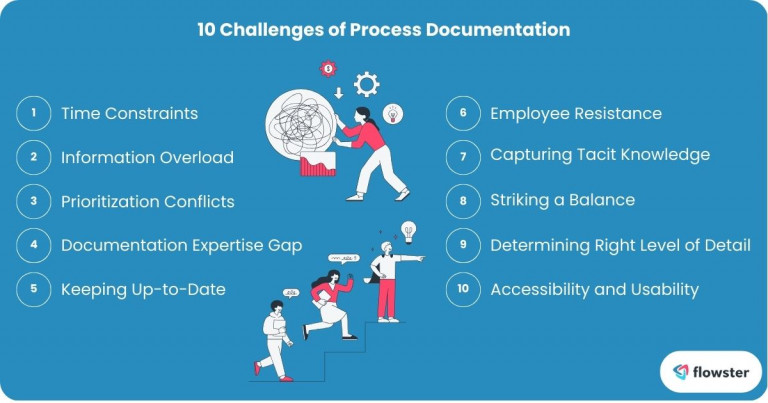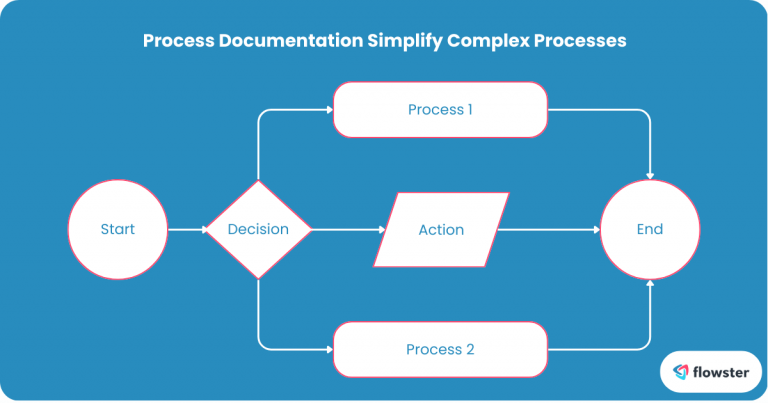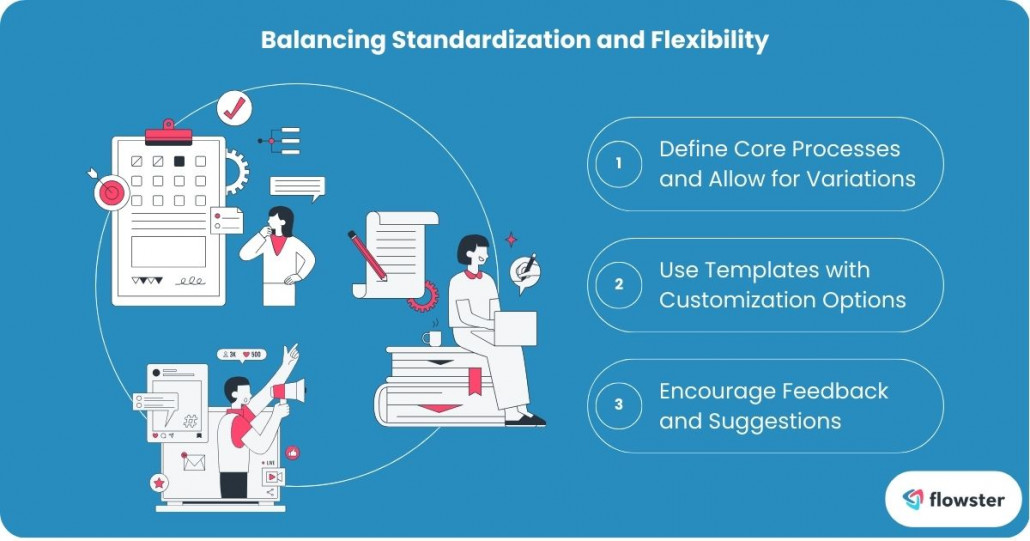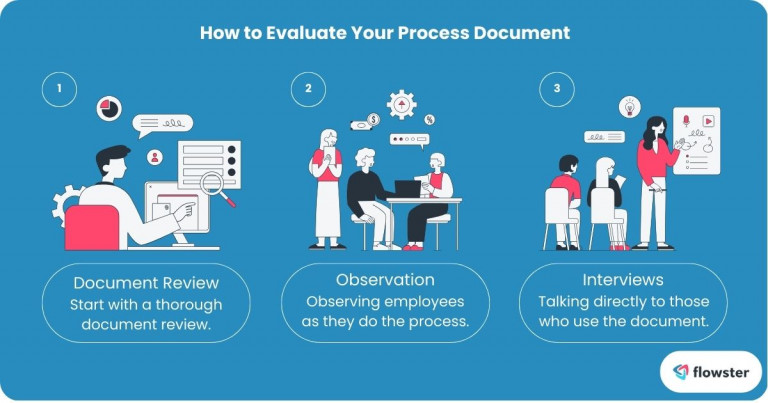Process documentation is a cornerstone of efficient and scalable operations. For small to medium businesses experiencing rapid growth, it’s essential for maintaining consistency, improving productivity, and ensuring knowledge transfer. However, many organizations grapple with process documentation challenges that hinder their ability to fully reap these benefits.
Common frustrations include time-consuming documentation, irrelevant details, conflicting priorities, and a lack of employee engagement. These issues can lead to outdated, inaccessible, and ineffective processes.
This post aims to equip you with practical strategies to address these hurdles. By the end, you’ll have a clear understanding of how to create a process documentation system that supports your business growth while minimizing common pitfalls.
Article Outline
Understanding the Process Documentation Challenges
Effectively addressing process documentation challenges is crucial for businesses aiming to streamline operations, improve efficiency, and foster growth. Let’s delve into the specific obstacles organizations often encounter.
Common Hurdles in Process Documentation
As mentioned earlier, teams frequently face a range of process documentation challenges. These issues can significantly impede process improvement efforts and hinder overall business performance.
- Time Constraints: Employees often feel overwhelmed by their existing workload, making dedicating time to process documentation a low priority.
- Information Overload: Including excessive details in processes can lead to confusion and hinder employee adoption.
- Prioritization Conflicts: Process documentation often takes a backseat to urgent business needs.
- Documentation Expertise Gap: Many teams lack the skills and knowledge to create effective process documentation.
- Keeping Up-to-Date: Ensuring process documentation aligns with evolving procedures is a continuous challenge.
- Employee Resistance: Gaining buy-in from employees for process documentation can be difficult.
- Capturing Tacit Knowledge: Documenting the informal knowledge held by experienced employees can be complex.
- Striking a Balance: Finding the right mix of standardization and flexibility in processes is essential.
- Determining the Right Level of Detail: Balancing simplicity and comprehensiveness in process documentation is challenging.
- Accessibility and Usability: Making process documentation easy to find and understand for all employees is crucial.
These challenges can collectively hinder business growth by creating inefficiencies, knowledge silos, and employee frustration. To overcome these obstacles and unlock the full potential of process documentation, we need to explore practical solutions. Let’s dive into strategies to address each of these challenges in the following sections.

Challenge 1: Employees Find It Time-Consuming
One of the most common process documentation challenges is the perception that it’s a time-consuming task. Employees often prioritize their core responsibilities over documenting their processes. This can lead to a backlog of undocumented procedures and hinder overall process improvement efforts.
The Employee Perspective
Employees are typically focused on completing their daily tasks and meeting deadlines. Adding process documentation to their workload can feel like an additional burden. They may question the value of documenting processes and how it contributes to their role.
Solutions
- Highlight Long-Term Benefits: Clearly communicate how process documentation improves efficiency, reduces errors, and supports career growth. By emphasizing the long-term advantages, employees can see the value in investing time in this task.
- Allocate Dedicated Time: Set aside specific time blocks for process documentation. This can be done individually or as a team activity. By treating it as a dedicated task, employees are more likely to prioritize it.
- Break Down the Process: Large, complex processes can seem overwhelming. Divide documentation into smaller, manageable steps. This approach makes the task less daunting and allows employees to focus on one section at a time.
By addressing these challenges and implementing these solutions, organizations can foster a culture where process documentation is seen as a valuable contribution to the team’s success.
Challenge 2: Includes Irrelevant Details
Another common process documentation challenge is the inclusion of excessive and unnecessary information. Overly complex documents can confuse employees and hinder process improvement efforts.
The Impact of Overly Complex Documentation
When process documentation is cluttered with irrelevant details, it becomes difficult for employees to quickly find the information they need. This can lead to frustration, errors, and decreased efficiency. Additionally, complex documents are more challenging to maintain and update, which can further hinder process improvement.
Solutions
- Define the Target Audience: Clearly identify who will be using the document. Tailoring the content to the specific needs of the audience ensures that only relevant information is included.
- Focus on Essential Steps and Decision Points: Prioritize the core elements of the process. Avoid including every single step unless it is critical for understanding the overall flow.
- Use Visual Aids: Flowcharts, diagrams, and other visual representations can simplify complex processes. Visuals make it easier for employees to understand the overall flow and identify key decision points.
By following these guidelines, organizations can create process documentation that is clear, concise, and easy to understand, ultimately improving employee efficiency and satisfaction.

Challenge 3: Conflicting Priorities
Another significant process documentation challenge is the competition for resources and attention. Process documentation often takes a backseat to more immediate and pressing business needs.
Why Documentation Takes a Backseat
In fast-paced business environments, urgent tasks and unexpected challenges can overshadow the importance of process documentation. Teams may prioritize firefighting and meeting short-term deadlines over building a foundation of documented processes. This can lead to inconsistent practices and knowledge gaps.
Solutions
- Tie Process Documentation to Business Goals: Clearly demonstrate how process documentation aligns with overall business objectives. By showcasing its contribution to efficiency, quality, and growth, it becomes easier to justify allocating resources.
- Create a Dedicated Process Improvement Team: Establish a cross-functional team focused on process improvement and documentation. This dedicated group can prioritize documentation efforts and drive change within the organization.
- Prioritize Documentation Based on Impact: Not all processes are created equal. Identify high-impact processes that have the greatest potential for improvement. Prioritize documentation efforts accordingly to maximize the return on investment.
By strategically addressing conflicting priorities, organizations can ensure that process documentation receives the attention it deserves and contributes to overall business success.
Challenge 4: Lack of Know-How on How to Document
A common process documentation challenge is the lack of knowledge and skills required to create effective and informative documents. Without proper guidance, teams may struggle to capture essential information and present it in a clear and understandable format.
Challenges of Creating Effective Documentation
Developing high-quality process documentation requires a combination of writing, organizational, and technical skills. Many employees may not have the necessary expertise to produce documents that are both comprehensive and user-friendly. Additionally, there may be inconsistencies in documentation style and format across different teams, leading to confusion and inefficiencies.
Solutions
- Provide Training and Resources: Offer workshops or online resources to equip employees with the skills needed to create effective process documentation. Cover topics such as document structure, writing style, and the use of visual aids.
- Use Templates and Guidelines: Develop standardized templates and guidelines to ensure consistency in documentation format and content. This simplifies the process for employees and improves document readability.
- Encourage Knowledge Sharing: Create a platform for employees to share best practices and tips for process documentation. This fosters a collaborative environment and helps everyone learn from each other.
By investing in training and providing the necessary tools and resources, organizations can empower employees to create high-quality process documentation that supports efficient operations.
Challenge 5: Maintaining Up-to-Date Documentation
Keeping process documentation current is a persistent process documentation challenge. As businesses evolve and processes change, it’s essential to ensure that documentation accurately reflects the latest practices.
Importance of Keeping Documentation Current
Outdated process documentation can lead to errors, inefficiencies, and frustration among employees. It’s crucial to maintain accurate and up-to-date documents to ensure that everyone is following the correct procedures. Additionally, current documentation supports continuous improvement efforts by providing a baseline for identifying areas for enhancement.
Solutions
- Assign Ownership for Each Document: Designate a specific person or team responsible for maintaining each document. This ensures accountability and facilitates timely updates.
- Establish a Review and Update Schedule: Implement a regular review process to assess the accuracy and relevance of process documentation. Schedule updates based on the frequency of process changes.
- Use Version Control: Track changes to process documentation by using version control software. This allows you to revert to previous versions if necessary and provides a history of modifications.
By following these strategies, organizations can maintain accurate and up-to-date process documentation that supports efficient operations and continuous improvement.
Challenge 6: Lack of Employee Engagement and Buy-In
Gaining employee buy-in and engagement is a critical aspect of overcoming process documentation challenges. Without active participation, it’s difficult to create accurate, up-to-date, and effective documentation.
Importance of Employee Involvement
Employees are the ones who execute processes on a daily basis. Their insights and knowledge are invaluable in creating accurate and useful process documentation. By involving employees in the documentation process, organizations can improve document quality, increase adoption, and foster a sense of ownership.
Solutions
- Communicate the Benefits Clearly: Explain how process documentation benefits employees, such as reducing errors, improving efficiency, and providing clear guidelines. By highlighting the advantages, you can generate enthusiasm and support.
- Involve Employees in the Documentation Process: Empower employees to contribute to the documentation process by conducting interviews, workshops, or knowledge-sharing sessions. This collaborative approach ensures that the documentation reflects real-world practices and builds a sense of ownership.
- Recognize and Reward Contributions: Acknowledge and appreciate employees’ contributions to process documentation. Offer incentives or public recognition to motivate participation and demonstrate the value of their involvement.
By fostering a culture of employee engagement and collaboration, organizations can create process documentation that is not only accurate but also valued and utilized by the entire team.
Challenge 7: Documenting Tacit Knowledge
Capturing tacit knowledge—the unspoken, often intuitive knowledge held by experienced employees—is one of the most significant process documentation challenges. This type of knowledge is difficult to articulate and transfer through written documentation.
Challenges of Capturing Unwritten Knowledge
Tacit knowledge is often embedded in an individual’s experience, intuition, and skills. It’s challenging to extract and document this knowledge because it’s often implicit and difficult to articulate. Additionally, employees may be reluctant to share their tacit knowledge, fearing job security or undervaluation.
Solutions
- Conduct Knowledge Transfer Sessions: Organize structured sessions where experienced employees share their knowledge and expertise with their colleagues. These sessions can be in the form of workshops, presentations, or one-on-one mentoring.
- Observe Experienced Employees: Shadowing experienced employees can provide valuable insights into their work processes and decision-making. By observing their actions and asking questions, you can uncover hidden knowledge.
- Use Interviews and Surveys: Conduct interviews or surveys to capture employees’ tacit knowledge. These methods allow you to gather information about their experiences, challenges, and problem-solving techniques.
By employing these strategies, organizations can effectively capture and transfer tacit knowledge, preserving valuable expertise and ensuring business continuity.
Challenge 8: Balancing Standardization and Flexibility
Achieving the right balance between standardized processes and flexibility is a critical process documentation challenge. Too much rigidity can hinder innovation, while excessive flexibility can lead to inconsistencies and inefficiencies.
Importance of Finding the Right Balance
Standardized processes promote efficiency, consistency, and quality. However, rigid adherence to procedures can stifle creativity and prevent employees from adapting to changing circumstances. On the other hand, excessive flexibility can lead to variations in processes, making it difficult to measure performance and identify areas for improvement.
Solutions
- Define Core Processes and Allow for Variations: Identify the core processes that are essential for business operations and standardize them. For other processes, allow for variations to accommodate different departments or teams.
- Use Templates with Customization Options: Provide employees with process templates that outline the basic structure and required information. However, allow for customization to accommodate specific needs and circumstances.
- Encourage Feedback and Suggestions: Create a culture where employees feel comfortable providing feedback on existing processes. This input can help identify opportunities for improvement and ensure that processes remain relevant and effective.
By carefully considering these factors, organizations can establish a balance between standardization and flexibility that optimizes efficiency, quality, and innovation.

Challenge 9: Determining the Right Level of Detail
Striking the right balance between providing too much or too little information is a common process documentation challenge. Insufficient detail can hinder understanding, while excessive detail can overwhelm readers and obscure essential information.
Impact of Too Much or Too Little Detail
- Overly Detailed Documentation: Excessive detail can make documents difficult to navigate and understand. Employees may become overwhelmed and ignore the document altogether. This can lead to inefficiencies and errors.
- Insufficient Detail: Lack of detail can hinder understanding and create ambiguity. Employees may struggle to follow processes correctly, leading to inconsistencies and quality issues.
Solutions
- Consider the Audience and Their Needs: Tailor the level of detail to the specific needs of the document’s audience. For example, a high-level overview might be sufficient for management, while detailed instructions may be necessary for frontline employees.
- Use Different Levels of Detail for Different Documents: Create different types of documents to accommodate varying levels of detail. For instance, a process summary can provide a high-level overview, while a detailed procedure can outline specific steps.
- Provide Additional Resources for Deeper Dives: For complex processes, offer supplementary materials such as FAQs, troubleshooting guides, or video tutorials to provide additional information for those who need it.
By carefully considering the appropriate level of detail, organizations can create process documentation that is informative, easy to understand, and effectively supports employees in their work.
Challenge 10: Ensuring Accessibility and Usability
Making process documentation easily accessible and user-friendly is a critical process documentation challenge. If employees can’t find or understand the information they need, the value of the documentation is diminished.
Importance of User-Friendly Documentation
User-friendly process documentation enhances employee productivity, reduces errors, and improves overall job satisfaction. When employees can quickly and easily find the information they need, they are more likely to follow procedures correctly and consistently.
Solutions
- Use Clear and Concise Language: Write in plain language, avoiding jargon and technical terms. Use short sentences and paragraphs to improve readability.
- Organize Information Logically: Structure documents in a clear and consistent manner, using headings, subheadings, and bullet points to guide readers. This helps employees quickly find the information they need.
- Provide Easy Access to Documents: Make process documentation readily available through a central repository or digital platform. Consider using a content management system to organize and categorize documents effectively.
By focusing on accessibility and usability, organizations can ensure that process documentation is a valuable resource that empowers employees and drives process improvement.
With this final challenge addressed, we’ve covered the most common hurdles organizations face when implementing process documentation. In the next section, we’ll summarize key points and provide actionable steps for overcoming these challenges.
Flowster's AI-Driven Automation
Overcoming Process Documentation Challenges: A Recap
Effective process documentation is essential for driving business growth, improving efficiency, and fostering a culture of continuous improvement. However, organizations often encounter a range of process documentation challenges that hinder their progress.
Throughout this post, we’ve explored common hurdles such as time constraints, information overload, conflicting priorities, and lack of employee engagement. We’ve also discussed solutions to address these challenges, including strategies for creating clear and concise documentation, involving employees in the process, and maintaining up-to-date information.
By implementing these recommendations, you can overcome process documentation challenges and build a robust system that supports your organization’s goals. Remember, effective process documentation is an ongoing journey, not a one-time project. Continuous improvement and employee involvement are key to maintaining a valuable resource.
Get Started Documenting Your Processes
Ready to take the next step? Flowster Marketplace offers a variety of free process documentation templates and other workflow templates to help you get started. These templates can serve as a foundation for your documentation efforts, saving you time and effort.
If you need additional support, Flowster also provides “Done-for-You” services to assist with your process documentation needs. Our experts can help you create comprehensive and effective documentation tailored to your organization’s specific requirements.
Don’t let process documentation challenges hold your business back. Start your journey towards streamlined operations and improved efficiency today!





